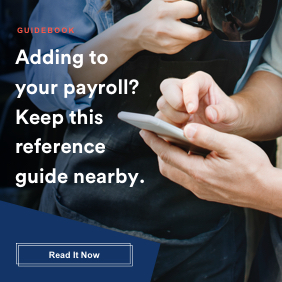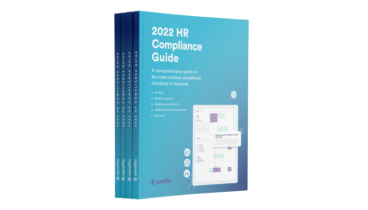Here are 5 signs that may mean you’ve outgrown your current payroll software and need to upgrade.

Here's what you need to know:
-
As your business grows, you'll likely need to upgrade your payroll software
-
Outdated payroll systems don't just affect HR — it can lead to unhappy employees too
-
Analyze your current software to find areas of improvement
As companies grow and their needs evolve, payroll becomes more and more challenging to manage. This is where third-party solutions step up for companies to simplify payroll. It’s more common than not for businesses to outgrow the payroll software initially adopted, and with this comes the temptation to switch. But is it worth it?
In most small business environments, a single person will be responsible for most payroll tasks, saving time and cost. However, as the company scales up and becomes more sophisticated, automated payroll software becomes a necessity. Many find it hard to know if their company has outgrown its payroll software without a list of requirements in mind.
Create a list of your payroll needs and conditions before looking for alternative solutions.
Create a list of your company’s payroll needs and conditions before you start looking for an alternative payroll software solution. QuickBooks is an option for small businesses but may be too simplistic for your company’s needs. Here are 5 surefire signs you need to update your payroll software.
Lack of payroll software choices
Starting out, it can be overwhelming to learn about all the different benefits offered by other packages. When faced with a limited number of choices, however, it appears sensible to find payroll software that works for the time being. Often, small to midsize businesses are quick to purchase payroll software when they launch. Some companies resort to services like Gusto or Quickbooks due to a lack of time or energy. Unfortunately, while these options may be easy to use, these payroll software solutions can’t fulfill their business needs as they expand and teams grow.
Although some payroll systems may be easy to use, they may not be suitable for growing companies.
If you are ready to take your business to the next level, the best approach is to choose a payroll solution that will grow with you and adapt to your changing business. Then, find a service that ensures your business is ready to take on current and potential payroll challenges.
Scalability of payroll software
When hiring more employees and handling more invoices, managing the workload with the same software can be challenging. You’ll need to scale your payroll software as you scale your company and have it adapt if you integrate other systems.
If your payroll system can’t keep up with your business demands, you can end up with compliance issues, data errors, and inaccurate payroll. If your business is growing, you can’t afford to be stuck with payroll software that doesn’t offer advanced features or cannot grow with you. Imagine the burden of adding more employees, managing interviews, and dealing with payroll issues with out-of-date software.
Employee complaints
When employees complain about something often enough, it’s a sure sign that it’s time to upgrade. There are many reasons why employees can be unhappy with adopted payroll software. What if the company’s payroll system is incompatible with its current business structure, does not work well with existing technology, or cannot converse with other payroll providers? If companies struggle to keep up with the changing business landscape, never mind keeping their employees happy, automating the payroll process might just do the trick.
When it comes to payroll software, you want a hands-off option so employees can focus on running the company rather than managing payroll. Choosing the right software will be time and money well spent.
Ease of use
A good payroll software needs a simple user interface to access payroll information and update it without working through any complex menus or flows. If your current software has a suite of features, including payroll templates, reporting, and the capability to add payroll checks, then you may not need to change anything.
However, payroll administrators will sometimes have to rely on Excel spreadsheets and manual processes. This less than desirable situation is primarily because their payroll systems lack the required functionality, are too cumbersome to navigate, or can’t integrate with other business software. If your payroll software is too complicated or is missing necessary features, now’s the time to change your software solution.
Vendor support for your payroll software
How would you rate the customer service support experience with your current vendor? If updates and upgrades are managed efficiently, do you have access to a knowledge base or a designated client advocate who will help you solve problems and improve company-wide software experience? Your vendor should ideally identify specific needs to help you reach longer-term goals.
Your provider should allow you to customize your product/service to suit your specific business needs with regular updates on new regulations, training, and technical support. If your software vendor does not provide training to help you get up to speed on the new rules, everything gets tougher to manage. If employees have to pull data manually, it will take longer to complete burdensome payroll tasks.
Whenever regulations and requirements change, review your payroll software to see if it’s still the right choice for you.
As payroll regulations and requirements become more complicated each year, be sure to review the technology you use to manage payroll. So when considering a new product or service, look for a vendor who’s proactive in guiding you through the legal processes in a way that any layperson could understand.
What works best for your organization?
What are the key considerations when choosing a payroll solution? Regardless of the size of your company, payroll plays a critical role. The optimal solution should keep the organization compliant, easily integrate with other systems and set up the organization for success and growth. Read our Payroll Setup Checklist to learn the key considerations when choosing a payroll solution.
Start by analyzing your current software to identify:
- Growth opportunities to
- Opportunities to automate manual processes
- Possible compliance issues
- Opportunities to integrate with other systems
Next, use the audit results to identify places where improvements can and should be made.
If you’re still using paper, consider migrating your payroll data to a more advanced, cloud-based payroll system. You’ll reduce the time spent on manual processes and minimize errors.
Honorable mentions
Automated payroll software can alleviate or remove most of the problems your company may have been experiencing during high growth periods. Other reasons to replace your software include:
- Your payroll processing takes too long.
- The software is not mobile-friendly.
- You are having issues with data accuracy.
- You want to save money on processing fees.
Let us know when you’re ready to take the first step in eliminating your payroll headaches.







